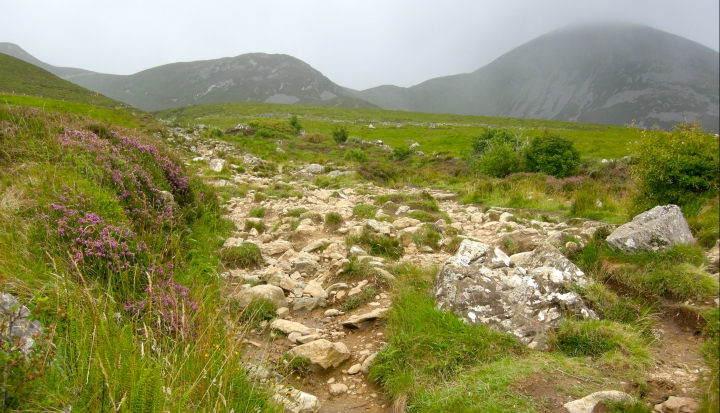A pilgrimage brings one traveler to the side of Ireland’s holy mountain.
A pilgrimage: That’s how I ended up sitting on the side of Ireland’s holy mountain, waiting for my husband and two kids to emerge from the clouds shrouding the ferociously windy summit, with darkness setting in.
Catholics have loved pilgrimages for centuries, long before Chaucer wrote The Canterbury Tales about pilgrims heading to the shrine of martyred St. Thomas Becket. Pilgrimages need not be officially religious. My drives with my mother to a lovely lake in Wisconsin qualified, I suspect: natural beauty, still water, food to restore the soul.
Our kids have been climbing mountains with us out in Colorado for years. Now at peak physical strength, they forge ahead, then wait for their parents to arrive, bestowing on us a patronizing smile as we struggle to catch our breath.
The one thing they both wanted to do in Ireland was climb Croagh Patrick, where St. Patrick fasted for 40 days and nights, listed misleadingly in guidebooks as a “gentle climb” that grandmothers and small children complete each year. I have my suspicions about those grandmothers.
This afternoon it isn’t raining, yet. The eighth-grader begins walking barefoot, as Irish penitents have for centuries. (Of course many Irish rarely wore shoes. My grandfather claimed, “I never had a shoe on my foot”—due to grinding poverty, not free-spiritedness.) She picks her way on grass and big rocks for about 45 minutes, bless her. Then gravel, and on go the boots, wings to her feet.
The trail climbs steadily, relentlessly. The wind yanks at my coat. After 90 minutes, weak-kneed and progressively more bad-tempered with being the straggler, I see the trail leveling off and—a miracle—a bathroom. God has obviously spoken. I settle down to wait while the others tackle the seemingly vertical path ahead. A lone climber passes by. “How about a banana, some chocolate?” he asks kindly.
Alone, I think of my mother, dead almost a year. I weep—how I miss her. Solitary in this cathedral of nature, I grasp that while my children and husband—my present—have literally vanished into the clouds, from this mountain I can see my past, the very places where my mother’s father and mother had been born, if I knew where to look. They had left and never returned, yet here I am. I pray, imagining generations of Irish climbing, hoping to leave their sins on the holy mountain.
Freezing, I wonder how St. Patrick held out up here for 40 days. A fur cloak, perhaps? Almost an hour now. The lone climber reappears. “I saw your people!” he says, smiling. “They were sprinting up!” I doubt it. I yell up the mountain: “Are you OK?” Nothing. More yells, then a faint answer: “We’re near the top.” I hear them calling to one another—a bad sign, I think. Did someone fall off? I calculate whether I can make it down to call the rescue squad before night falls. If I don’t slip and break an ankle.
I glue my eyes to the path, hoping to see a human shape descending. I finally notice three dots—ever so slowly moving down the steep rocks now slick with drizzle. Maybe I can cancel the rescue squad idea. My husband says the winds at the summit blew so fiercely he feared for their safety and hustled them down again.
Alvin Fine writes, “We see that victory lies not at some high place along the way/ But in having made the journey, stage by stage, a sacred pilgrimage.” I slip and fall only once on the way down. And I don’t break a thing.
This article originally appeared in At Home with Our Faith, Claretian Publications’ print newsletter for parents on nurturing spirituality in the home.
Flickr photo cc by IrishFireside











